We’ve frequently touched on how Scarcity Zero is based on a mindset of standardization and modularity. If you recall, modularity is the idea of designing a system to be flexible yet standardized in deployment. A great example of this are USB accessories. Devices of all kinds – from webcams to smartphones to external hard drives – can connect to your computer via the same standardized USB port, yet can be modularly added, removed or swapped with ease.
Another familiar example is an AC power cable. Every electronic device in your home connects to power via the same type of standardized plug. Each device doesn’t have its own unique connection – that would be a crazy mess! That’s why they’re all built to a universal standard. Audio/visual ports (HDMI), and Bluetooth devices are all extensions of this idea.
Standardizing a function to be modular reduces complications for building things and lowers the bar (and research + development costs) for manufacturing. For these reasons, standardization and modularity are driving principles when building sophisticated products. But these principles have only been taken so far.
We saw earlier how most power plants are built as unique entities – they might standardize a doorway, railing or stairwell, but the system as a whole is essentially made to order. The same is true with most larger-scale things in our society. With few exceptions, every bridge built, tunnel dug, railway laid or building erected was done so as a custom entity – made to order, each and every time. This is because we are presently living in a world with technical limitations that would make it difficult to build something like a skyscraper or bridge on a factory assembly line. Removing this limitation is one of the final functions Scarcity Zero is intended to perform.
With a nigh-unlimited supply of all critical resources – especially energy, fuel and materials – we have the building blocks to build as much as we want, however we want. As we further have sophisticated computing and modeling, next-generation manufacturing with advanced synthetics and precise tolerances, we can automate the construction of sophisticated systems on a larger scale.
The application of this idea is commonly known as “prefabrication” – building something in a factory and assembling it at a final location instead of constructing it from scratch with basic building materials. It’s an approach we’ve been improving for years, but recent advances in manufacturing have enabled us to increase its scale, sophistication and potential applications.[1]
For example, this is a prefabricated house:
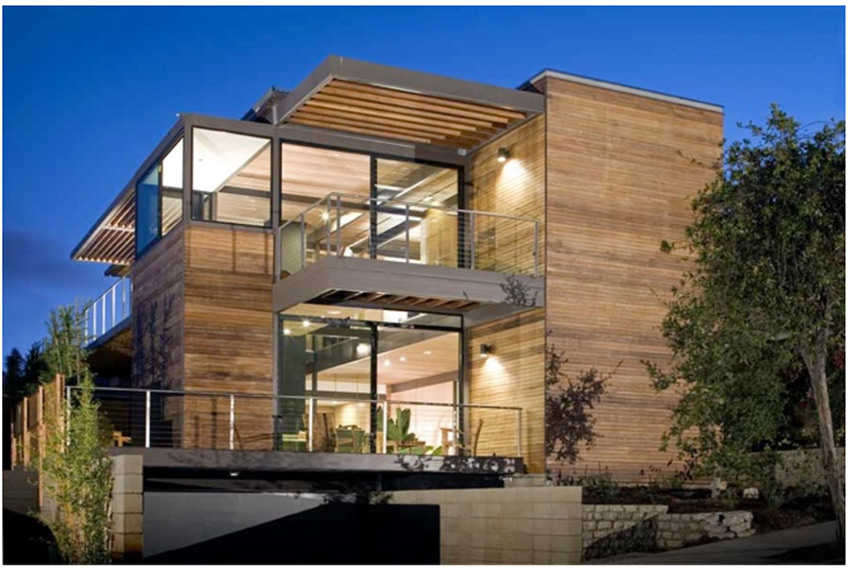
This house was not constructed at this location, it was assembled here. There were no workers on-site cutting wood for framing or nailing in subfloors. Pieces of this house were built on a factory assembly line, just like we build vehicles. They were delivered by a truck to a construction site, and this house was assembled in a matter of days.
This house came with a finished interior, with all electrical, plumbing and heating elements pre-installed. Should the homeowners decide one day that they want to expand the size of their home, it would be a matter of bringing in a new piece, removing modular components from the original house, and fastening the new piece into the whole. If they wanted to move, they could disassemble their house, put it on trucks, and assemble it again somewhere else. Essentially, we can now build houses with life-sized Legos.
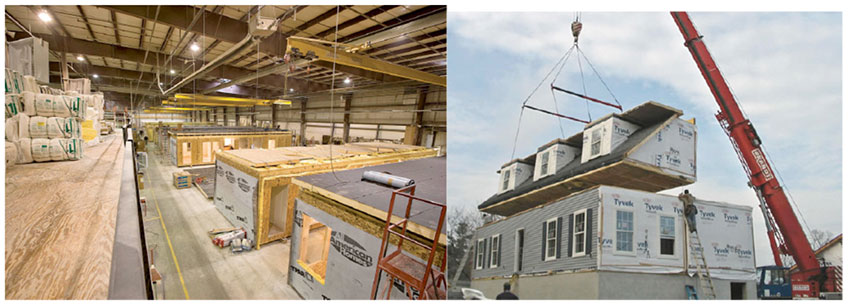
Prefabricated houses have been growing in popularity,[2] especially since they offer high energy efficiency and durability. However, the price of these homes is still comparatively steep. Today, the cost to deliver a fully finished prefabricated house ranges between $140-$200 per square foot or more, considerably higher than the $125 per square foot national average for a traditionally constructed home.[3]
But this price range includes expenses inherent to any fledgling industry – initial research and development, prototyping, and marketing among them – and those costs have to be recouped through fewer sales in a smaller-if-growing market. The energy and materials needed to construct and transport these prefabricated homes are also a considerable expense. Scarcity Zero helps to mitigate these cost factors, and with current and coming advances in synthetic materials, the total cost of these houses could drop significantly.
Houses are only one example of the potential benefits of prefabrication, as practically anything can be built this way: LFTRs, renewable energy, Multi-Stage Flash Distillation Facilities, hydrogen production systems, CHP Plants, National Aqueduct and urban vertical farm components, Trident Facilities, and even larger buildings and civil infrastructure.
To understand the implications of prefabrication, take a look at the following two images. The image below and to the left shows the Boeing Corporation's Everett, Washington facility that can mass-manufacture a complete 737 jet aircraft every nine days.[4] Their flagship 787 Dreamliner aircraft can be manufactured to completion in as few as seventeen days.[5] (Don’t let the indictable corner-cutting[6] of the 737 MAX scandal fool you, either – both Boeing and Airbus have been mass-manufacturing commercial aircraft with 100% safety reliability for years). The image below and to the right shows a 30-story prefabricated structure built by the Broad Sustainable Buildings corporation in Changsha, China that was assembled on-site in 15 days.[7] That’s two stories of a building, per day.
For comparison: both of these feats were accomplished faster than the time it takes Budweiser to brew a bottle of beer.[8]
The start-to finish timeline of the four pictures below is 15 days.

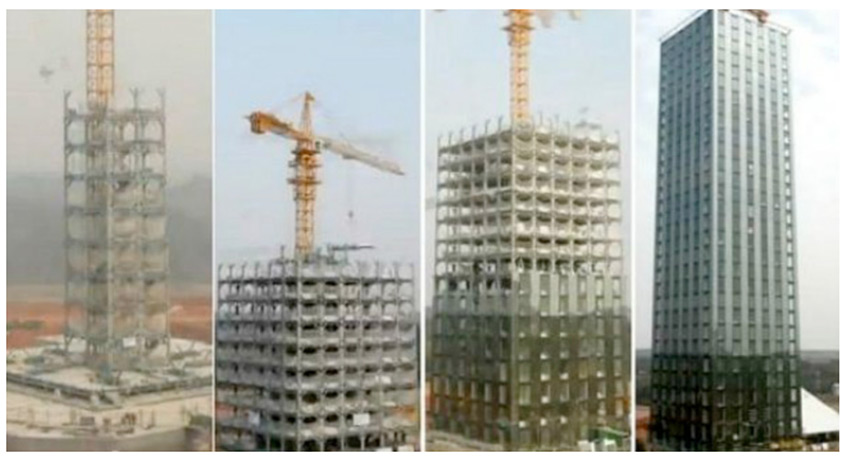
These achievements were accomplished with today’s technology. With the energy cost reductions and improvements to both manufacturing and materials Scarcity Zero brings, the possibilities expand. We can sustainably prefabricate essentially whatever we want on massive scales, and we can build it better and less expensively than we can today. This enables us to dramatically advance our economy, society and infrastructure. But we can also ensure shelter as a resource – which brings us back to housing. At this scale of manufacturing prowess, building small residences on assembly lines becomes trivial.
For example, the images below show houses made from shipping containers – the same kind used to transport goods on trucks and cargo ships. Shipping containers are so inexpensive to make that in some cases, it’s actually cheaper to use new containers than it is to ship the empty ones back to their origin.[9] Thousands of containers nationwide are routinely left near shipping yards, prompting innovative architects to use them as housing:
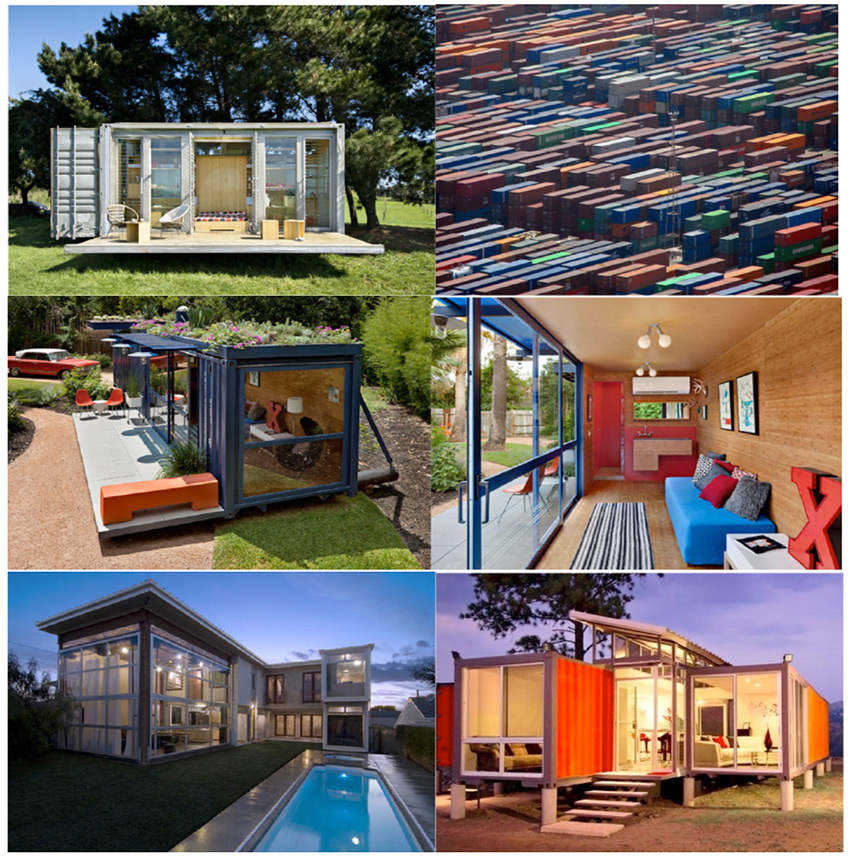
Shipping containers are plentiful and, naturally, easy to transport. Each container is made from steel, which is extremely resilient and boasts a high load strength. With today’s energy, shipping, and manufacturing costs, a single-container home can be delivered for between $20,000-$40,000.[10] The last home on the previous page, for example, was fully constructed for less than $40,000.[11] If energy and material expense reductions are applied by way of Scarcity Zero, these costs would likely drop substantially.
Shipping containers are far from our only prefabricated housing option. U.S. tech startup ICON, for example, can prefabricate a 650-square-foot house in less than 24 hours at a cost of $10,000 or less.[12] They use a large 3D printer to pour a concrete mix layer by layer, creating a solid structure that’s significantly stronger than traditional stick-framed construction. The company has already built more than 800 homes in partnership with local communities in Bolivia, Mexico, Haiti, and El Salvador.[13] In developing nations, the company estimates homes like the ones below could be manufactured for less than $4,000.[14] ICON’s market sector is shared by companies in Russia,[15] Dubai[16] and Amsterdam that manufacture comparable models.[17]
![]()
The MADi corporation in Italy has taken a different approach, using folding joints to create small residences that can be set up in hours.

As a modular, standardized structure with a base cost below $40,000, MADi folding house shapes can be integrated together and extended to feature a wide array of configurations:
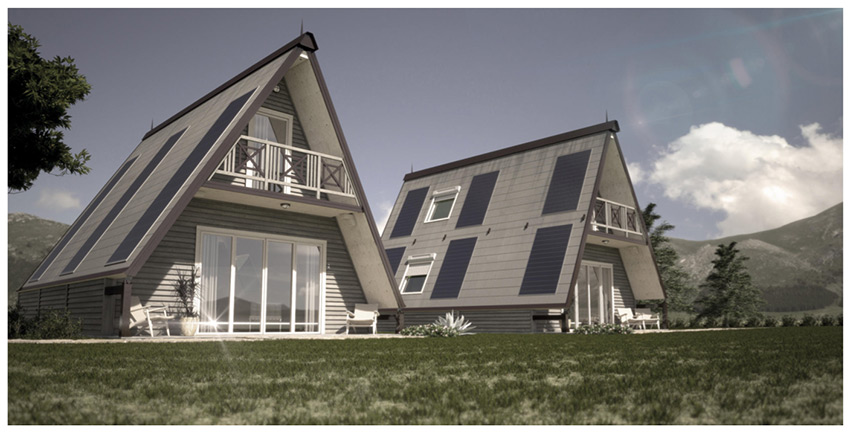
These advances in prefabricated residential construction have given our society a cost-effective method of manufacturing and transporting housing structures practically anywhere, especially structures built small enough to be deployed on smaller plots of land that are either publicly owned, extended via land grant or purchased using charitable funds – further increasing social utility and philanthropic value.
But what are the greater implications of the expansion of materials and construction methods for smaller-scale residential dwelling? Most importantly, for a modest investment we can now provide quality living spaces for anyone who needs a home, such as:
Victims of natural disasters. As events like Hurricanes Katrina, Harvey, Maria and Dorian have demonstrated – alongside tornados, flooding and ever-worsening wildfires around the world – millions of people can be displaced from their homes after natural disasters. Displacement traditionally leads to depression, social unrest, higher crime, and reduced economic activity, among other social problems – all of which are often cyclical in nature.
While temporary FEMA trailers have provided some relief in the U.S., these shelters are only free to use for a limited time, and at $70,000 per unit, each costs several times as much to produce than a prefabricated living space of similar size.[18] Rather than using the more expensive temporary FEMA trailers, we can now deliver inexpensive prefabricated homes that can have integrated heat and hot water, giving a comfortable, warm, and private space to people who have lost their homes in the U.S. and abroad.
For example, during the 2010 Haiti Earthquake and its aftermath, roughly 105,000 homes were destroyed and another 208,000 badly damaged.[19] International governments devoted millions of dollars to assist, with some $93 million going to build some 2,600 homes – a cost of roughly $36,000 a house. Though approximately $13 billion in total international aid was donated so that Haiti could rebuild, much of the country today looks little different from how it did in the immediate aftermath of the earthquake.[20] Had we been able to purchase prefabricated homes at $30,000 each, it would have cost $9.3 billion – meaning that we’d have provided living spaces to replace every damaged and destroyed home with another $3.7 billion to spare.
Low-income/fiscally reserved individuals. The average price for a single-family home in the United States is nearly $300,000 – an obstacle for even the median wage earner in this country.[21] The millions of families who are forced to rent are in an increasingly precarious financial situation, as rent prices have largely increased in inflation-adjusted dollars over the past 30 years while median income has not.[22]
Perhaps a family can’t afford to buy a house and are forced to rent at the expense of their ability to save money or invest in something they own. Conversely, perhaps a family wishes to purchase a modest home on a larger plot of land with more cash on hand as opposed to a more expensive house with a heavier mortgage. Prefabricated homes make either possible, allowing people to take advantage of the value of home ownership at lower prices than are possible today.
People experiencing homelessness. There are currently an estimated 565,000 homeless people in the United States,[23] and every year the Federal Government spends approximately $4.5 billion on efforts to reduce that number.[24] Assuming a cost of $30,000 for a small prefabricated home, we could provide a comfortable and private living space for every homeless person in this country for $19 billion. Assuming $10,000 for a 650 square foot 3D-printed home, we could provide the same for just $6.5 billion. That’s what the Federal government spends on preventing homelessness every 2-5 years. Also of note: that’s between 1-3% of the annual defense budget.[25]
It’s worth mentioning that providing a private living space to get people off the streets isn’t necessarily going to fix any underlying reasons for their homelessness, as afflictions like drug addiction and mental illness are often factors.[26] But reaching the ability to extend the most vulnerable among us a place to live and rebuild their lives is key to solving major social problems. The lowest a person in the United States (and perhaps abroad) would thus be able to fall to is a private living space with heat, food and hot water – a historical first.
Being able to accomplish these goals in aggregate is a milestone of major significance. It represents a massive leap in our societal advancement, and more critically, it’s the final nail in the coffin of resource scarcity.
By combining the systems described in this and previous chapters, we would have the means to synthetically produce everything we need to exist: electricity, fuel, water, food, advanced building materials, and now shelter, and we would have the means to produce them far less expensively than we can today.
Indefinitely sustainable production of the crucial resources and amenities our civilization needs to function would be revolutionary, completely changing how we relate to people within our neighborhoods, our nation and our planet.
Critically, this would allow us to reset our relationship to nature.
Since we evolved from hunter-gatherer tribes and started building societies, the environment around us has paid the price. We have razed forests, destroyed ecosystems and altered our planet’s climate. The rise of human civilization, in and of itself, has been an extinction-level event. Scarcity Zero allows us to chart a different course because it can provide every resource that we need to exist and advance without relying on perpetually invasive extractive technologies. This alone greatly reduces the damage we inflict on nature by decreasing our reliance on what are essentially finite resources.
It’s true that technological advances might increase the extraction of certain materials. But with superior recycling and manufacturing methods, this can be minimized and would ultimately pale in comparison to the other environmental benefits we would see with Scarcity Zero. We would no longer need to cut down forests for building materials, extract finite sources of oil and gas for energy, or devote swaths of land for farming. We would no longer need to deplete natural water sources for drinking, industry, or agriculture. We would no longer need to pollute our atmosphere or destroy waterways with toxic chemicals. Over time, the Scarcity Zero framework would allow nature to return to its natural state, and heal to a point before our hands scarred it.
And, this would remove the primary cause of human conflict.
For thousands of years, for thousands, we have butchered each other. Whether by the sword, the arrow, the bullet or the bomb, we have exterminated our brethren in every horrific manner we could think of. In this doing we have told ourselves lies, and allowed ourselves to believe that we were justified in killing and dying by the millions for causes that boiled down to nothing more than resource scarcity and the pursuit of the money, power and economic might it bestows on the winner of its zero-sum games. We have believed these lies and lived with these horrors because we had no other choice. And whether near or far from the results of their manifestation, we have been powerless to prevent it all from repeating for time eternal because we had no means to truly change how the world worked.
Now, we do.
Technology can finally empower us to evolve beyond the zero-sum game of resources. No matter how much energy, water, food or materials are consumed by society, we can always generate more. With that, we can not only build transformational things, but further transform the very means and tools with which we build them – and change the world from the old model to the new.
Paradigm Shift
Scarcity Zero is first and foremost a framework, and its ultimate purpose is to make a new model for our society. It doesn’t seek to use money to pay for social programs that mitigate social problems. It instead seeks to use money to build systems that make those problems irrelevant.
10,000 years ago, making fire was a problem. Today, you use a lighter. 300 years ago, transportation over distance was a problem. Today, you hop in a car, bus, train, or plane. 100 years ago, communication was a problem. Today, a phone call can reach any corner of the globe. Right now, today, energy and resources are a problem.
Through technology, they don’t have to be a problem tomorrow.
For millennia, resource scarcity has been central to human interaction at an individual and societal level, chaining and binding us to its restrictions. With its bounds removed, we can focus the entirety of our social strength towards transforming our civilization into something unprecedented.
By dramatically lowering the costs of energy, resources, and materials while improving the quality of life for everyone, costs fall, as does the amount of resources that have to be devoted to addressing social afflictions. This frees up collective funds that could be devoted to social advancement, and the same goes for industry, which would have greatly increased capabilities to build ever-greater accomplishments.
In a scarcity-free world, we would have unlimited potential to discover, create, construct and achieve. That world, and the economy it would power, is a future that we can begin building today.
And that, above all else, is a future worth having.
A future worth having. That is what we strove for once, and it’s something we can strive for again. Yet in order to do so we must recapture the vision we once lost, a vision we once cherished: the drive to build great and amazing things. Minus the shiny new weapons systems that consume trillions of dollars decade in, decade out, that collective drive has been forsaken.
The past six decades saw us build the interstate highway system, put a man on the moon and invent GPS and the internet. We didn’t care about difficulty or political opposition – we achieved those goals because we could and because they proved to ourselves that we were worthy of rising to the occasion as both a people and a species.
Today, amidst the backdrop of our crumbling roads, collapsing bridges and aging skyscrapers, we are living within a decaying testament to the greatness we once sought and collectively built. And we’ve lowered ourselves to bickering, bitterly, over ideological squabbles and petty partisanship about how we’re going to build anything of actual societal value, for ourselves, for those who will come after, and for those who once looked to us as models to follow.
That is not who we are, and that is not where we came from. We deserve a better future than Ozymandias, and Scarcity Zero is how we may see it realized. We can see it realized because the framework has a tertiary function that becomes possible when we move past a finite-resource dynamic. Once we stop chasing our tails and wasting untold blood and treasure in the name of resource dominance, it allows us to devote our full strength as a civilization to advance ourselves even further to a new stage of technological and humanitarian evolution – one that ultimately sees us build a world we thought possible only in dreams.
